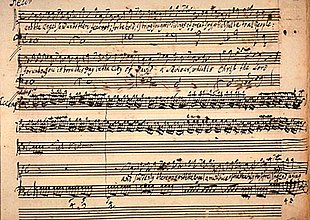| Messiah | |
|---|---|
| (Part I) | |
| by George Frideric Handel | |
 Manuscript of Nos. 15–16, Annunciation to the shepherds | |
| Year | 1741 |
| Period | Baroque |
| Genre | Oratorio |
| Text | Charles Jennens, a compilation from the King James Bible and the Book of Common Prayer |
| Composed | 22 August 1741 – 14 September 1741: London |
| Movements | 21 in five scenes |
| Vocal | SATB choir and solo |
| Instrumental |
|
Messiah (HWV 56), the English-language oratorio composed by George Frideric Handel in 1741, is structured in three parts. The wordbook (also called libretto or text) was supplied by Charles Jennens. This article covers Part I and describes the relation of the musical setting to the text. Part I begins with the prophecy of the Messiah and his virgin birth by several prophets, namely Isaiah. His birth is still rendered in words by Isaiah, followed by the annunciation to the shepherds as the only scene from a Gospel in the oratorio, and reflections on the Messiah's deeds. Part II covers the Passion, death, resurrection, ascension, and the later spreading of the Gospel. Part III concentrates on Paul's teaching of the resurrection of the dead and Christ's glorification in heaven.
The popular Part I of Messiah is sometimes called the "Christmas" portion[1] as it is frequently performed during Advent in concert, sing-along, or as a Scratch Messiah. When performed in this way, it usually concludes with "Hallelujah" (chorus) from Part II as the finale.
